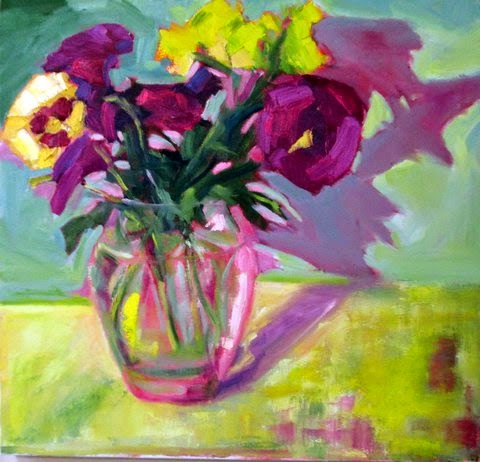Plein Air Series, Part 3- Painting at the Speed of Light
Plein Air Series, Part 3
Painting at the Speed of Light
It's a game of beat the clock when you decide to go outdoors on paint en plein air. If there is a technique to getting the image I want while the light changes with the passage of time or the changes in the weather, it is this: decide on the underlying value pattern at the beginning and then stick to it. It's easy to say here but very hard to do at times.Painting at the Speed of Light
 |
| "Trio" © Janet Ledoux • private collection
The above painting, "Trio" is 12" x 12 " oil on wood, done entirely on site on Vinalhaven Island.
|
I think the paintings come out best when I see something, draw a pencil design or several of them in a sketchbook, and pick the most interesting pattern to go forward with. Then, with Mineral Spirits and a big brush, I keep half an eye on my sketch while thinning some paint and creating that interesting pattern from the sketchbook on the canvas. What color? It depends; and in a way it doesn't really matter all that much. I often use a few different colors to keep the first layer of paint interesting, but the important thing is that it looks like one darkish shape and that it's interesting. I'll wipe parts of it away and add to it until I'm OK with it. My goal is to get it there within a half hour or so. It won't be the darkest value, but it will be close.
Then, I paint directly using this value underpainting as my shadow shape no matter what happens in front of me with the light moving overhead and the shadows changing and all that. The dark pattern shape might get covered with a different color or change a bit, but I try not to "chase the sun". This has really worked for me. Often I only have 3 hours or so to paint before the scene in front of me has changed so much it doesn't make sense to be there. With this technique I am not going back and forth changing the painting so much.
I remember when I made the above painting "Trio" that the light moved so fast it was a completely different shadow on the rocks within 90 minutes or so, but I could use the color cues from other areas in the scene to create the shadow colors on my painted rock and trees.
I have to admit that I do cheat. If there is a really cool light effect late in my painting session I'll just put it in anyway even though it alters the initial light pattern somewhat. Hey, it's not a photograph so if I like it I'll add it. I try to be careful not to wreck the whole idea, but there is always room for intuitive changes and deviation from the plan. I just think it's better to start with a good plan.
There is an interesting You Tube video about his experience with ALS that clearly shows his grace and optimism. Give it a look, you'll be inspired.
Remembering Jon Imber
1950-2014
I met Jon Imber while I was standing on the library porch along Main Street in Stonington, Maine. He and his wife, artist Jill Hoy, were strolling down the street heading to grab some dinner on an absolutely spectacular late September afternoon. I was facing the length of the street painting the late light and had been there every afternoon for a week. We talked for awhile about the perils of working in a public spot and he was generous and funny and very down to earth.
Stonington has been some kind of magnet for many artists. Jon had called it home for half the year for many years, and he seemed to know everyone, such is the case with small town living. He will be greatly missed by a lot of people.
 |
| © Jon Imber "Spring Totem" |
There is an interesting You Tube video about his experience with ALS that clearly shows his grace and optimism. Give it a look, you'll be inspired.


Comments
Post a Comment